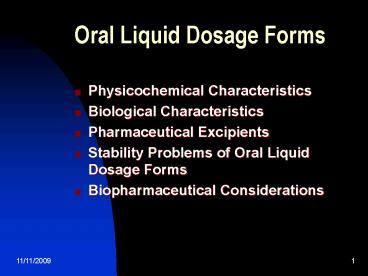Oral Liquid Dosage Forms - PowerPoint PPT Presentation
1 / 18
Title:
Oral Liquid Dosage Forms
Description:
Suspension. Emulsion. Physicochemical Characterization. Molecular dispersed system ... Suspension. Slowest onset of action. Sustained drug release ... – PowerPoint PPT presentation
Number of Views:7990
Avg rating:3.0/5.0
Title: Oral Liquid Dosage Forms
1
Oral Liquid Dosage Forms
- Physicochemical Characteristics
- Biological Characteristics
- Pharmaceutical Excipients
- Stability Problems of Oral Liquid Dosage Forms
- Biopharmaceutical Considerations
2
Physical Characteristics
- Appearance
- Solution
- Suspension
- Emulsion
- Physicochemical Characterization
- Molecular dispersed system
- Coarse dispersed system
3
Physicochemical Characteristics
- Thermodynamically Stable
- Solution
- Thermodynamically Unstable
- Suspension
- Emulsion
When something is themodynamically stable, it
usually maintains its physical form.
4
Physical Characteristics
- Solution
- Molecular dispersion Clear
- Pleasing to the eyes
- Clear
- Suspension
- Cloudy
- Visible change with time
- Emulsion
- Grease vs. smooth
- Viscous
5
Physical Characteristics
- Solution
- Apparent taste
- Apparent smell
- Suspension
- Slower drug release
- Less taste or smell
- Emulsion
- Medium drug release rate
- Significant taste or smell
6
Biological Characteristics
- Solution
- Rapid onset of action
- Compliance problem
- Suspension
- Slowest onset of action
- Sustained drug release
- Easier to dose drugs with bad taste/smell
- Emulsion
- Compliance problem
- Slower onset of action
7
Pharmaceutical Excipients
- Excipients do not have pharmacological activities
themselves and shall not enhance or diminish the
pharmacological activities of the active species. - Excipients are used in the manufacturing or the
compounding process for the purposes of - Maintaining the appearance
- Protecting the active species
- Disguising the unpleasant taste/smell
- Changing the dissolution rates of active species
8
Pharmaceutical Excipients for Solution
- Maintaining the appearance
- Color
- Clarity
- Preservatives
- Surfactants
- Protecting the active species
- Buffers
- Antioxidants
- Disguising the unpleasant taste/smell
- Sugar
- Flavoring agents
- Changing the dissolution rates of active species
- Not applicable
9
Pharmaceutical Excipients for Suspension
- Maintaining the appearance
- Color
- Preservatives
- Viscosity agents
- Flocculating agents
- Protecting the active species
- Buffer pH
- Antioxidant
- Less soluble particles
- Disguising the unpleasant taste/smell
- Sugar
- Flavoring agents
- Less soluble particles
- Changing the dissolution rates of active species
- Different salt forms
- Different particle size
- Different solvent compositions
10
Flocculating Agents
- These are the most important agents to maintain a
relatively constant particle size - Themodynamic Unstable because
- Particle size uneven and too small
- Incorrect charges
- Density too high
11
Flocculating Agents
- Mechanisms of Action
- Lower zeta potentials
- Electrolytes
- Ionic surfactants
- Build a gel-like network
- Polymer with proper cross-linker
- Viscosity modifications
- Polysaccharides Alginates Starchs
- Water soluble cellulose
- Hydrated silicates
- Synthetic polymers
- Colloidal solutions
12
Types of Suspensions
- Deflocculating systems
- Minimize sedimentation with viscosity enhancers
- Flocculating systems
- Controllable and reversible sedimentation
13
Pharmaceutical Excipients for Emulsion
- Maintaining the appearance
- Color
- Consistency
- Preservatives
- Protecting the active species
- Buffers
- Antioxidants
- Alternative distribution pattern
- Disguising the unpleasant taste/smell
- Sugar
- Flavoring agents
- Percent oil vs. water
- Changing the dissolution rates of active species
- Particle size of drug-containing dispersed phase
14
Types of Emulsions
- Contain at least two immiscible liquid phases
one called continuous phase, the other
dispersed phase - Oil (dispersed) in water (continuous) o/w
- Water in oil w/o
- Themodynamically unstable because of large
surface tensions
15
Emulsifying Agents
- Purpose Stable dosage form
- Functions
- Reduce surface tension
- Maintain particle size of the dispersed phase
- Types
- Ionic surfactants
- Nonionic surfactants
- Polysaccharide derivatives and others
16
Stability Problems
- Solution
- Color change
- Loss of active component
- Clarity changes
- Suspensions
- Inability to resuspend the particles
- loss of significant amounts of active component
is less likely because of the lower solubility. - Emulsion
- Creaming
- Breaking (coalescence)
17
Biopharmaceutical Considerations
- Solution
- Rapid release and faster onset than any other
oral dosage forms - Less variations
- Suspension
- Less smell and taste
- Longer dosing intervale
- Emulsion
- Not used often
- Used when it is absolutely necessary
- Many products for parenteral nutrition
18
End of Oral Liquid Dosage Forms

